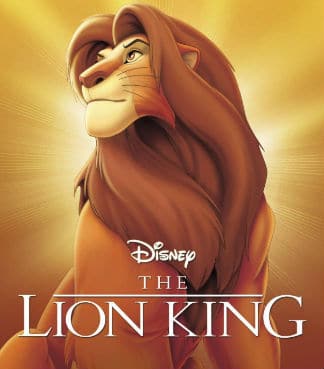
Welcome to Revisiting Disney! Today, we are looking at the surprising hit that went on to be a film I would consider a timeless classic, The Lion King! Like always, I have labeled each category so if you want to skip to the parts that interest you most, feel free. And, of course, if you have any thoughts, burning or otherwise, please share in the comments!
BACKGROUND OF THE LION KING
Released on June 24th, 1994, the funny thing about The Lion King is that it was not supposed to be a hit. In the “Making Of” feature, Peter Schneider, who had been the President of Walt Disney Feature Animation describes The Lion King as “the film no one was supposed to care about.” Pocahontas was supposed to be the big hit (we’ll come back to that film next week).
However, The Lion King was wildly popular, going on to win the 1995 Golden Globe for Best Motion Picture, Comedy or Musical (and several other awards for music, but we’ll come back to that). Altogether, The Lion King won 28 awards and had received 26 other nominations.
In addition to that, several people on staff call themselves the “B Squad,” with the team on Pocahontas being the “A Squad.” Artistic Coordinator Randy Fullmer mentions that people wanted to leave The Lion King to work on Pocahontas while Artistic Supervisor and Story Team Member Brenda Chapman also remembers that Lion King was the “B Picture.” Production Designer Chris Sanders, however, said that he felt that everyone would rather work on the “B Picture,” so there was a sense of “underdog pride” in the film.
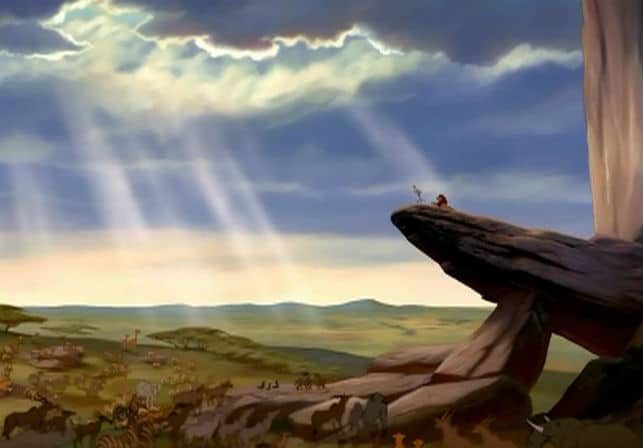
Photo: Disney
The Lion King, then, really gave the younger animators a chance to shine. Produced by Don Hahn (who had served as producer on Beauty and the Beast), The Lion King was directed by Roger Allers (who had served on the story team for multiple Disney films, including The Little Mermaid, Oliver and Company, and Aladdin), and Rob Minkoff (who had served as an animator in The Little Mermaid, The Great Mouse Detective and The Black Cauldron).
Hans Bacher, who was involved in character design and visual development remembers that when the story was described to him, it was described as “Bambi in Africa,” and there are other variations on that idea. My personal favorite is “Bambi in Africa with Hamlet thrown in, so Bamblet.” I’m going to be circulating a petition to rename The Lion King as Bamblet, so be looking for that.
MUSIC
The Lion King was nominated for several awards, and, like Beauty and the Beast before it, it won several of them. At the 1995 Golden Globes, the song “The Circle of Life” was nominated for Best Original Song, Motion Picture, only to lose out to “Can You Feel the Love Tonight.” The film also won Best Original Score, Motion Picture. At the Academy Awards in the same year, the film won the same two awards, with “Hakuna Matata” also being nominated in the Best Music, Original Song category.
The musical team behind The Lion King is made up of Hans Zimmer, Elton John, Tim Rice, and Lebo M. Hans Zimmer also wrote the score for Sons of Liberty, Inception, The Dark Knight Rises, The Holiday, and Muppet Treasure Island, among many, many others. The man is amazing; the first score he’s recorded as writing came out in 1984, and he’s written over 100 through his career. He tends to use aspects of the cultures that the story is based in throughout his music, something that shows in The Lion King.
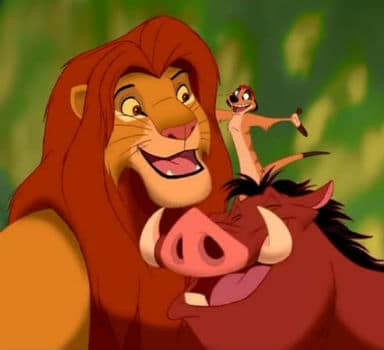
Photo: Disney
Lebo M. was the performer of “Circle of Life” in the movie, and he also served as the choral arranger and conductor in the film. He went on to work on “The Rhythm of the Pride Lands: Music Inspired by Disney’s The Lion King,” which would be used in the Broadway musical (and the sequel), making his contributions a major part of why the film is such a hit.
Tim Rice, who wrote the lyrics for the songs, had previously worked on Aladdin and would go on to work on the lyrics for Toy Story. He also served as a lyricist on Broadway, for Evita, Jesus Christ Superstar, and Joseph and the Amazing Technicolor Dreamcoat with Andrew Lloyd Webber, and with Elton John on Aida. The two men would also work on the music for The Road to El Dorado in 2000.
Elton John is a Grammy award winning singer. He wrote an award-winning musical, “Billy Elliot The Musical,” has won at least two Tony’s, has a Star on the Hollywood Walk of Fame for Recording, and is estimated to have sold 250 million albums during his career thus far.
I look at the mix of Lebo M and Elton John as part of the reason this film works. These songs should not fit together as well as they do. These musical men were collaborating and with the use of Han Zimmer’s score and all the ways they put it all together, it all just works. It’s brilliant.
ANIMATION
The Lion King, like other films in the 1990’s, uses computer-generated animation in some aspects of the film, but it shines particularly in one set-piece. For The Lion King, this set-piece was the wildebeest stampede. The reason for this, explains Thomas, is that this allowed the team to “accomplish something that never could have been possible by animators alone” (Thomas 1992: 143).
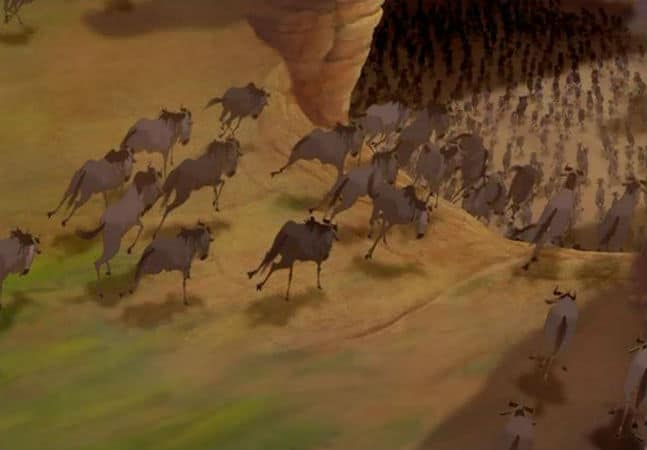
Photo: Disney
First, animator Ruben Aquino drew a model sheet, basically a model of what the wildebeest should be doing during the stampede. Then, the computer animators created a 3D rendering of that 2D animation. This made it possible for the animation to spin, ie, you can see it from all angles.
Secondly, this design was replicated into 700 wildebeests (each with their own shadows). To get the stampede, a computer program was created that allowed the animators to control the animals without having them run into each other. This was then put into the hand-painted background and the hand-drawn Simba was added in as well.
Six members of the team traveled to Africa in 1991 to get a feel for the scope and grandeur of the landscape. They also frequently had animals in the Studio, like they had for Bambi, The Jungle Book and Lady and the Tramp, to make sure that the movements were being captured as accurately as possible. The animators also watched some of those older films to capture those moments. Bob Thomas reports that the animators also went to the zoo, brought in a biologist, and watched nature footage (Thomas 1992:139).
For the film, the production team wanted to make the setting, Africa itself, into a character. There had been a discussion about what sort of background would be best; the storybook theme ala Sleeping Beauty, a more cartoony feel, or a more distant and grand feel.
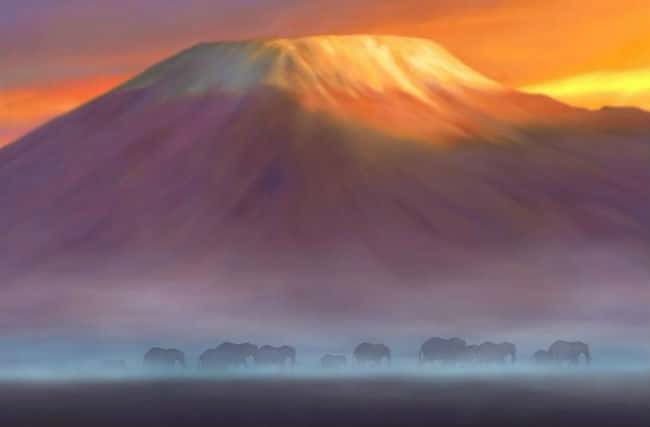
Photo: Disney
In the end, the style was designed to be epic, and Art Direct Andy Gaskill was trying to capture the feel that was captured in the grand and epic films like Lawrence of Arabia (Thomas 1992:139).
THE PLOT
The story begins with the birth and presentation of a young lion cub, who we learn is named Simba. He is the young prince, and heir to the position of leader of his pride and defender of the Pride Lands after the death of his father, the noble Mufasa.
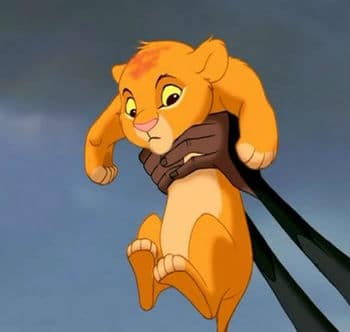
Photo: Disney
However, all is not well in the pride. Mufasa’s brother, Scar, is bitter that he won’t be king now that his brother has an heir. Although he says he wouldn’t challenge Mufasa, because Mufasa is stronger than he is, he also mentions that he is very clever. This sets off flags that Scar is the one to watch out for. Also, he tries to eat Zazu, the plucky comic relief! He has to be a villain!
Time passes, and Mufasa begins to teach young Simba about the Pride Lands, explaining that he has a duty as king to protect the land and the creatures there, because they’re all connected in the “Circle of Life.” He also tells Simba that there is a shadowy place that is beyond the borders of the Pride Lands and that that land is off limits (because we all know that that always works so well).
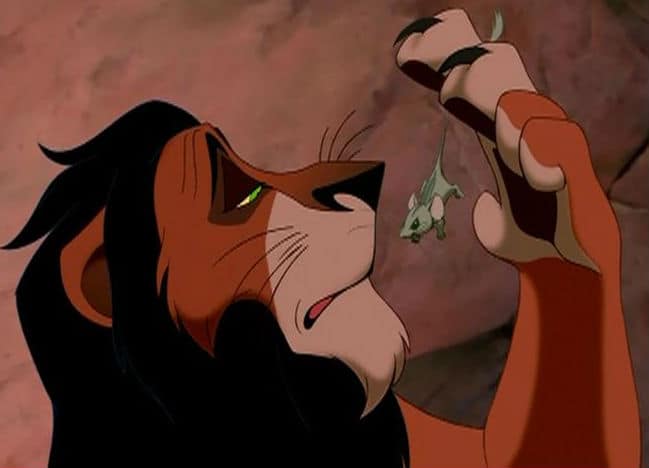
Photo: Disney
Simba runs to tell his Uncle Scar about what he’s learned, and when he mentions the Shadowy Place, Scar casually mentions that it’s an elephant graveyard and that only the bravest lions go there. Simba takes that as a challenge (as it was intended) and tracks down his friend Nala, both determined to be brave and go see this cool place.
Getting permission from their mothers to go exploring as long as they take Zazu (Mufasa’s advisor) with them, the two set out to this forbidden place, headed to the watering hole and trying to figure out how to ditch their babysitter. Zazu ruins their fun when he tells them that they’re going to get married one day (which horrifies them both).
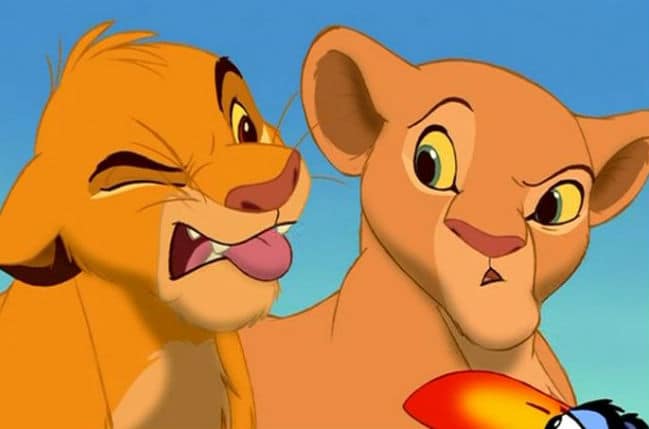
Photo: Disney
They manage to lose Zazu and find themselves in the elephant graveyard. Turns out, it’s forbidden because it’s the home of the hyenas, who have been exiled from the Pride Lands and have anger toward Mufasa. Knowing whose son Simba is, they decide to kill him, just because they’re hungry and they can. After an exciting chase where they are separated from Zazu, the cubs are cornered. Luckily, Zazu has found and brought Mufasa, who saves the day.
Simba is in trouble because he had one rule and he broke it. He and Nala both could have died because of his actions. When Simba tells his father that he was just trying to be brave like him, because Mufasa isn’t afraid of anything, his father tells him that even kings get scared, and being brave doesn’t mean you go looking for trouble.
This is also the point in the story where Mufasa tells Simba that the great kings of the past are looking down on them from the stars and that those kings will be there to guide Simba if he feels alone. Even if Mufasa is not there physically, he will still there for Simba, always.
We cut to the hyenas, and it turns out that Scar was working with them all along! The plan had been to both feed the hyenas and to remove Simba from the picture. He tells them that the cubs were basically gift-wrapped, but they still escaped. Worst minions ever. The hyenas point out that, in their defense, the cubs had help from Mufasa, and follow-up by asking if they were supposed to kill Mufasa too. Scar says to go ahead and kill his brother.
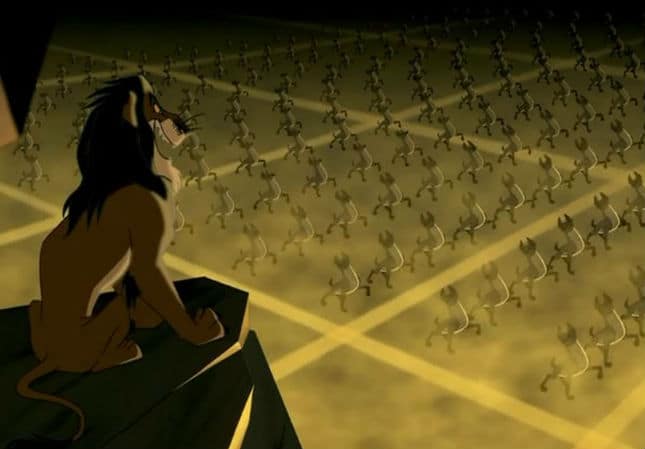
Photo: Disney
He rallies the hyenas with the promise of food forever and begins to create his plan to take over the pride. The hyena army is enormous, and things are going to get bad for the lions, I’m sure. At this point, Scar is pretty solidly in the “bad guy camp” now, if I had been unsure before. Parts of this scene and song remind me of old videos of Nazis marching, so that’s always unsettling to see in an animated film.
Scar’s plan is set into motion by luring Simba into a gorge that is used for herds to move through the Pride Lands, and then having his hyena friends start a wildebeest stampede. Simba is trapped and in danger of being trampled to death. However, I’ve always wondered, why did Simba still trust Scar, after he baited him into going to the elephant graveyard? I mean, the flags should be flying right now!
Part two of the plan involves Scar getting Mufasa and telling him that Simba is trapped in the stampede. They race to save Simba; Mufasa running into the stampede to save his son. Zazu is knocked unconscious by Scar when he tries to go back to the rest of the pride for help.
Mufasa is able to save Simba, placing him on the ledge before he himself is swept away in the stampede. Being the awesome king he is, however, Mufasa is able to jump up out of the chaos and begins to climb up the side of the gorge. When he reaches the top, however, he is exhausted and, seeing his brother at the top of the cliff, asks for help.
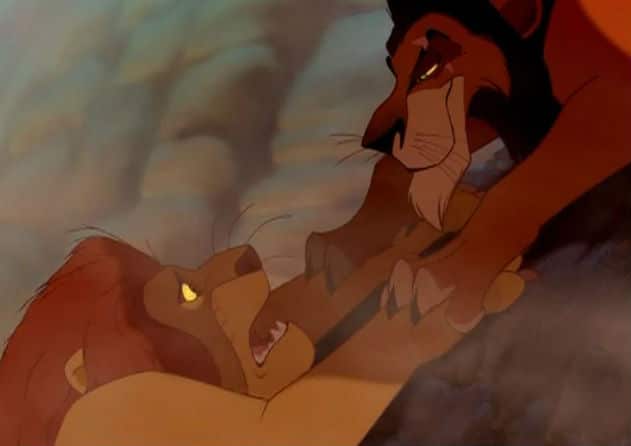
Photo: Disney
Scar grabs him, but whispers “Long Live the King” in his ear, before throwing his into the stampede. This fall results in Mufasa’s death, and a horrified Simba watches, helpless, as his father falls. After the stampede, Simba finds his father and tries to wake him up, only to realize that his father is gone.
Scar suddenly appears and comforts his nephew, while subtly shifting the blame for Mufasa’s death onto the young Simba, encouraging him to run away. As Simba takes off, Scar sends his hyena friends to kill the young lion. Simba escapes by running through a thorn patch, only to find himself lost in a desert.
The hyenas, who don’t want to run through the thorns, decide to tell Scar that Simba is dead and yell that they’ll kill him if he ever returns. Claiming that both Simba and Mufasa are death, Scar assumes the throne. His first action is to bring the hyenas into the pride lands, so they can roam unchecked over the landscape (I feel like, before, these two predators kept each other in check, in some ways).
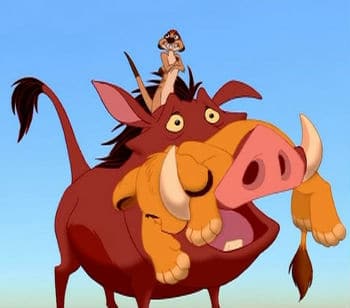
Photo: Disney
Meanwhile, Simba is near death when he is saved by everyone’s favorite meerkat and warthog duo, Timon and Pumbaa. The two revive our young hero and take him in. They teach him a new motto: Hakuna Matata, which means no worries. Simba embraces this carefree lifestyle because he can’t face his past, still thinking that he killed his father. He grows up and continues to wrestle with his past, no matter how hard he tries to forget it.
Rafiki, meanwhile, has discovered that Simba is still alive, and is determined to bring the rightful king back to his throne.
A lioness shows up one day and tries to kill Pumbaa (because he is technically food). He is saved by Simba, and it turns out that the lioness is Nala. She and Simba are, it turns out, a good romantic pair, and things seem to be going well for them. However, Nala has come to find help; Scar is a bad king and has let the hyenas take over and run amok. Like, the pride lands have died and the herds have left, that’s how bad of a leader Scar is. Reminding Simba that he needs to come back because it’s his responsibility, he tells her that she sounds like his father and leaves, angrily.
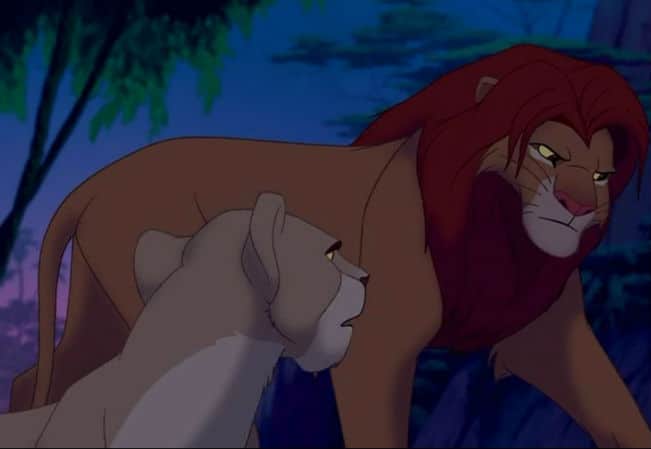
Photo: Disney
At this point, Simba finds Rafiki, who catches his interest when he calls him “Mufasa’s boy” and tells him that he knows his father. After a wild goose chase, Simba is disappointed to only see his reflection in the pool Rafiki shows him. Rafiki chastises him, however, to look harder, because his father lives in him. When Simba looks again, Mufasa appears in the water and then in the clouds. He tells his son that he is more than he has become, and tells him to remember who he is.
This inspires Simba to do the right, though hard, thing, and he heads back to the pride lands to challenge Scar for the throne. Nala, Timon, and Pumbaa are close behind him (though the later are only fighting out of love for their adopted child). Timon and Pumbaa create a diversion while Nala finds the lionesses and Simba hunts for Scar, who is surprised to see him.
When it becomes clear that Simba could easily kill him, Scar taunts Simba with his past, telling the lionesses that Simba was responsible for Mufasa’s death. Backing his nephew up to the ledge of Pride Rock, Scar watches in glee as Simba begins to struggle to not fall off the edge. As Simba is about to fall to his death, Scar leans over and tells him the truth, that Simba was innocent.

Photo: Disney
Enraged, Simba decides to take vengeance for his father’s death and his own years of guilt, leaping off the edge and forcing Scar to tell the truth. This starts a battle between Scar and the hyenas and Simba, the lionesses, Timon, Pumbaa, and Rafiki. The good guys are winning when Simba sees Scar trying to escape. He gives chase, and, although Scar tries to blame the hyenas, Simba is not buying it. He agrees to spare his uncle’s life as long as Scar goes into exile (because he’s a not like his uncle).
Scar is not willing to go without a fight, and, flicking coals into Simba’s eyes, he attacks. Simba wins the fight and throws Scar down into a pit, where the hyenas, who heard him throw them under the bus, attack, killing Scar. It begins to rain, and Simba walks to the edge of Pride Rock and lets out a roar, symbolizing that he is the new king. The lionesses answer, the rain falls, the herds come back, and the film ends with Simba and Nala’s cub being lifted in the same ceremony Simba himself went through. The circle of life continues.
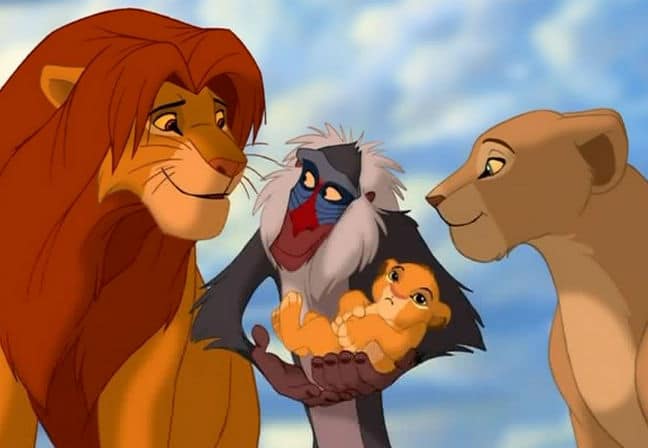
Photo: Disney
SOURCE MATERIAL
Listening to the production team talking about the inspiration for The Lion King, I was expecting them to talk about Hamlet. However, I had not been expecting Moses and Joseph to be named-dropped. The team speaks mostly to trying to make a story that would speak to the human experience at large, using betrayal, redemption, family, responsibility. When they started weaving those things into their story, they started to see parallels with the classic stories, including Hamlet.
The production team talks about how they were really playing with a particular archetype, that of the hero’s journey, but that is such a universal and well-loved story, that it comes across as being based on particular tales. The story of The Lion King takes bits from all of these stories in that style, which makes it part of a grand storytelling tradition.
The Joseph parallel comes from the story of Joseph, who was exiled from his home. When his family sees him again, they don’t recognize him, but he is able to save them all. He was raised in virtual royalty, before losing everything, and these aspects can be seen in Simba’s journey.
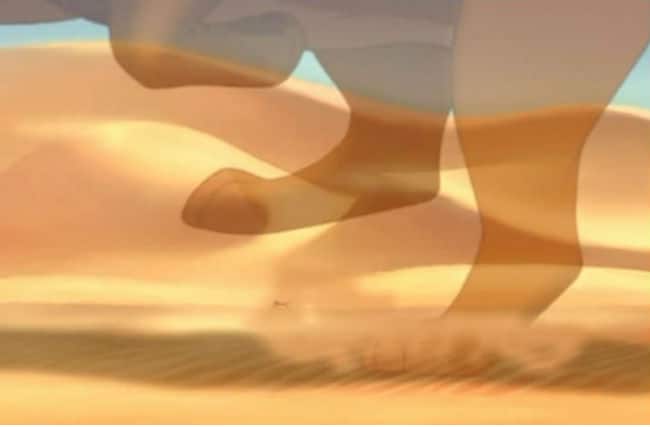
Photo: Disney
The connection that the team seems to mention the most, (after Hamlet), however, is the Moses connection. The parallel to the story of Moses is one that I never connected to The Lion King before though now I can totally see it. I was too stuck on the Hamlet connection, I suppose. Moses was raised as a prince, like Simba, and both have a life of relative ease. While Moses killed someone intentionally and Simba only thinks he killed someone, both run off into the desert, until they are confronted with their past, which sends them home to liberate their people and face down a tyrant.
The Hamlet thing, apparently, was something that the production team realized later. They had been talking about having Scar as a rogue lion but thought it was more interesting if he was in the pride. Then, having him related to the family added another layer to the story. As director Roger Allers said, “So we made him the brother, and then all of a sudden: Uh-Oh! We started seeing the Hamlet angle.”
Co-Writer Irene Mecchi, who coined the term Bamblet, also emphasizes the Shakespeare connection as more than the story. She saw it in the juxtaposition of the tragedy and the comedy in The Lion King; how one second we’re crying for Mufasa and the next, we’re laughing at Timon and Pumba. They call it a “tragedy that was hopeful,” and that works.
Of course, once the Hamlet connection is there, it was hard to ignore. There are actually a lot of lines in The Lion King that are based in Shakespeare, which cracks me up. The production team says that the scene where Simba sees Mufasa in the clouds is their version of the “To Be or Not To Be” speech, with some “Moses and the Burning Bush” thrown in there.
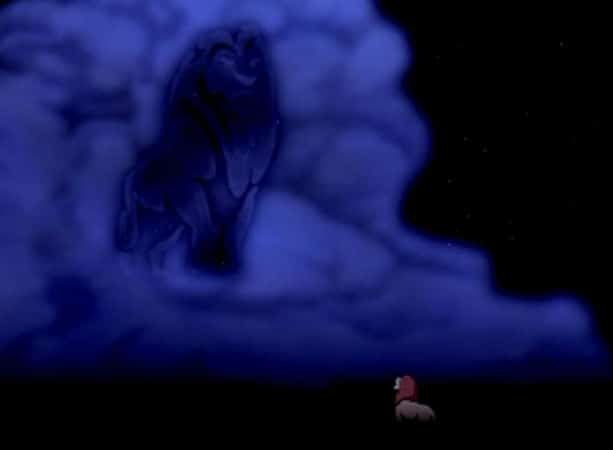
Photo: Disney
I’ve never seen Kimba the White Lion, so I’m going to point out that the filmmakers say that they were working on the concept of the great epic tales and how they related to the human experience. Basically, it’s very possible that there’s some overlap, but I think it does The Lion King and its team, and Kimba and its team, a disservice to claim foul play.
The 1990’s
This week, our “What Happened in the 1990’s?” continues with 1993 and 1994. In 1993, the Band “New Kids on the Block” breaks up, and Michael Jordan retires. He goes on to play minor league baseball, and it is apparently not a home run for him. Jordan will rejoin the NBA in a year and a half. This was also the year that beanie babies were launched, and the first bagless vacuum cleaner was invented.
In more serious news, the World Trade Center was bombed by a Fundamentalist Islamic group, a ferry in Haiti sunk (and over a thousand people died), 300 people died in bombings in India, an earthquake in Japan leads into a tsunami that kills 202 people, an earthquake in India kills almost 10,000, an oil tanker runs aground in the North Sea, and the FBI raids Waco, Texas.
1994 was a monumental year in South Africa, in that it was the first election in that country where black citizens were allowed to vote. Nelson Mandela was elected the first black South African president. In less happy news, Rwanda is rocked by civil war between the majority and minority groups (Hutus and Tutsis), after the president is assassinated. Many, many people are killed.
Meanwhile, back in the States, figure skater Nancy Kerrigan is attacked by people working for one of her rivals, Tonya Harding. Kerrigan was still able to win the silver medal at the Winter Olympics, which were held in Norway that year. Other news stories include rising tension due to the inspection of nuclear plants in North Korea, the approval of GM Foods, the Channel Tunnel is opened between Britain and France, Serbia continues to attack Bosnia, the United States invades Haiti and restores democracy, the Northridge Earthquake hits the San Fernando Valley, and 48 people in a Swiss Cult commit suicide (Order of the Solar Tradition).
Overall, The Lion King could have soared to popularity due to the lesson of carrying on. When bad things happen, the human spirit can and does endure. Nelson Mandela, for example, had been released from prison in 1992 and was now president of his country in a historic election. All the horrible things that were happening in the world would not destroy it; we would keep fighting (like Nancy Kerrigan).
Plus, the songs are amazing and the animation is stunning. Also, The Lion King does, like I said in above, look at one of the oldest stories, the coming of age epic. That’s a story that never goes out of style.
LESSONS LEARNED
The first lesson here is the importance of responsibility, and owning up to those responsibilities. Simba has to face his past and take responsibility for his actions. He also has a responsibility to protect his family and people. Although he tries to escape those duties, he can’t. It’s hard sometimes, but that ends the droughts and helps us find our purpose.

Photo: Disney
Another lesson is that the past can hurt, but we can either run from it or learn from it. I realize that this really is part of the first lesson, but I love this scene and how it’s played.
Another lesson is that it’s important to remember that the people we love don’t ever actually leave us. They are always there, watching over us. The Lion King is pretty deep, actually, because with this it also talks about how we can’t shirk our responsibilities because of grief. The best way to honor our loved ones who have moved on is by living.
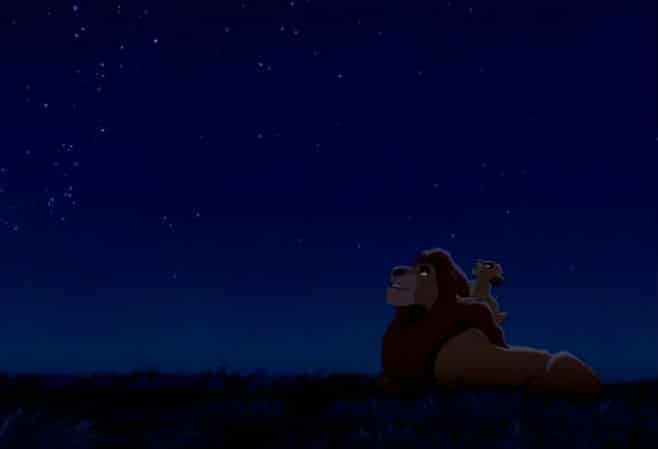
Photo: Disney
Another lesson is that, no matter how awful things are, or how hard things are, we can get through them. The human spirit is made for fighting. This, to me, folds into a lesson about the importance of family, the people who help you through the hard times. Although The Lion King is more about the relationship between fathers and sons, it can be generalized to include families.
Another lesson is that being brave doesn’t mean you go looking for trouble.
Finally, the last lesson that struck me was the idea that comes out of the song “Circle of Life;” we all are part of something bigger than ourselves. We all have a role to play in our world, and we can make a bigger impact than we may ever know.
DOES IT HOLD UP?
I think this film holds up, having spawned two television series and two film sequels. It’s one of the most difficult Disney movies to get your hands on, because no one wants to sell their copies, which, to me, says a lot about it. As one of many children who used their cat as a baby Simba, I was delighted to see that, on a rewatch, The Lion King still holds up. The music, the story, the animation, the characters…it’s truly an epic told in animated form.
For next week: Pocahontas
If you enjoyed this post and the others in the Revisiting Disney series, and have found yourself wishing that you could find them all in one convenient and bound book with eight extra essays, there is an option for you! Check out A Journey Through Disney: My Look Back Through Disney Canon, now available on Amazon as both a Kindle book ($4.99) and a paperback ($11.99).
OTHER SOURCES:
https://thewaltdisneycompany.com/about-disney/disney-history
http://www.imdb.com
http://studioservices.go.com/disneystudios/history.html
http://www.thepeoplehistory.com/1994.html
http://www.kidzworld.com/article/4255-1990s-timeline
Bailey, Adrian. Walt Disney’s World of Fantasy. Everest House Publishers. New York, New York. 1982.
Finch, Christopher. The Art of Walt Disney: From Mickey Mouse to the Magic Kingdom. Harry N. Abrams, Inc. New York, New York. 1975.
Johnston, Ollie and Frank Thomas. The Disney Villain. Hyperion. New York, New York. 1993.
Sale, Roger. Fairy Tales and After: From Snow White to E.B. White. Harvard University Press. Cambridge, MA, 1978.
Tatar, Maria. The Annotated Classic Fairy Tales. W.W. Norton and Company. New York and London, 2002.
Thomas, Bob. Disney’s Art of Animation From Mickey Mouse to Hercules. Hyperion. New York, New York. 1992.
Wright, Gordon. The Ordeal of Total War: 1939-1945. Harper Torchbooks, Harper & Row. New York, Hagerstown, San Francisco, and London, 1968.
ARE YOU A ROMANCE FAN? FOLLOW THE SILVER PETTICOAT REVIEW:
 Our romance-themed entertainment site is on a mission to help you find the best period dramas, romance movies, TV shows, and books. Other topics include Jane Austen, Classic Hollywood, TV Couples, Fairy Tales, Romantic Living, Romanticism, and more. We’re damsels not in distress fighting for the all-new optimistic Romantic Revolution. Join us and subscribe. For more information, see our About, Old-Fashioned Romance 101, Modern Romanticism 101, and Romantic Living 101.
Our romance-themed entertainment site is on a mission to help you find the best period dramas, romance movies, TV shows, and books. Other topics include Jane Austen, Classic Hollywood, TV Couples, Fairy Tales, Romantic Living, Romanticism, and more. We’re damsels not in distress fighting for the all-new optimistic Romantic Revolution. Join us and subscribe. For more information, see our About, Old-Fashioned Romance 101, Modern Romanticism 101, and Romantic Living 101.

Comments are closed.